Having a transmitter board at MHM is a good idea. (Thanks Greg)
Taking it a step further, let's post what frequencies we're planning on using in this thread, so that those of us with adjustable frequencies can set theirs up ahead of time to be out of the way. My beeline is set to 433.975 now. I think that's far enough from 433.75 to be o.k., but if someone wants me to pick something different, let me know.
Having a transmitter board at MHM is a good idea. (Thanks Greg)
Taking it a step further, let's post what frequencies we're planning on using in this thread, so that those of us with adjustable frequencies can set theirs up ahead of time to be out of the way. My beeline is set to 433.975 now. I think that's far enough from 433.75 to be o.k., but if someone wants me to pick something different, let me know.
Adrian, the Adept transmitters fluctuate pretty wildly, and occupy a much wider band than you might expect. FWIW, I don't think 433.975 is far enough away (sorry!). I totally concur, the transmitter board is a terrific idea.
Adept claims to be 433.9 MHz, but 433.000 - 434.000 is pretty strong. One tyipically has to detune a *lot* to find things - though nothing has ever gone lost when deployment occured.
At the launches (especially the larger ones), I think it would be wise to have the signup board for ANY radio transmitting equipment, be it Adept, Rocket Hunter, Walston, Garmin dog tracker, Garmin Rino, FRS radios, GMRS radios, etc.
I haven't ground tested for interference, but I'll hopefully be flying the Rino setup in Excess in Moderation. I'll just be running on FRS channels for now.
I believe the sudden growth of tracking in our club is a mix of technology getting cheaper and rocketeers willing to spend a bit more money to recover their ever more expensive rockets. To what end? You add the radio and GPS, now you've got an even more expensive rocket if you lose it, so you invest more in the tracking, then...
My reason for the investment is I'd much rather see my bird shred, cato, or lawndart than recover cleanly and get lost.
Ken
Concerning the Garmin Astro 220 with an on-board DC20, I do not believe that the dog (rocket) trackers will interfere with other radio systems. The Rhino series are using the FMRS and GMRS bands so they do not conflict with the Astro 220 system.
There area 5 MURS frequencies used for data transmission which are NOT selectable by the user. The Astro 220 will automatically assign frequencies and Identifying codes. These are close to the FM Ham 2 meter band and CB channel frequencies.
151.82 MHz
151.88 MHz
151.94 MHz
154.57 MHz
154.60 MHz
Now as far as DC20's stomping on DC20's it would be advantageous to insure that any DC20 installed in a rocket has an ID different than someone else's DC20, so an ID management system should be arranged within the club, or at an event.
Any handheld, once it learns or identifies a DC20 with a specific ID, can track that rocket along with another handheld tracking the same rocket. However the handheld is used to name and set parameters (like the ID) so it would be good to insure that one does not try and make changes to someone elses DC20 in a rocket.
I talked with Garmin on the limitations, and so far what I have gleaned that we could assign 10 rocket ID's to 5 handhelds which would cover a total of 50 rockets. The support person said not to assign ID number next to each other, 1,2,3,4,5,6, etc as they have seen some drop outs.
So, if the club has five (5) Astro 220's in its membership, and we have rockets with DC20's that are going to fly the same day, we could (ahead of time) assign ID's to the handhelds as follows:
Astro 220 #1: Dc20 ID's 0, 5, 10, 15, 20, 25, 30, 35, 40, 45 (Mike, John W)
Astro 220 #2: Dc20 ID's 1, 6, 11, 16, 21, 26, 31, 36, 41, 46 (John S., Art, ...)
Astro 220 #3: Dc20 ID's 2, 7, 12, 17, 22, 27, 32, 37, 42, 47
Astro 220 #4: Dc20 ID's 3, 8, 13, 18, 23, 28, 33, 38, 43, 48
Astro 220 #5: Dc20 ID's 4, 9, 14, 19, 24, 29, 34, 39, 44, 49
This series would be easy for anyone having a handheld to remember and as more handhelds are acquired the ID's assignments would be taken from the above handhelds and given to the new guys. Fore example, having ten (10) members with handhelds in the club coulod be allocated thus:
Astro 220 #1: Dc20 ID's 0, 5, 10, 15, 20
Astro 220 #2: Dc20 ID's 1, 6, 11, 16, 21
Astro 220 #3: Dc20 ID's 2, 7, 12, 17, 22
Astro 220 #4: Dc20 ID's 3, 8, 13, 18, 23
Astro 220 #5: Dc20 ID's 4, 9, 14, 19, 24
Astro 220 #6: Dc20 ID's 25, 30, 35, 40, 45
Astro 220 #7: Dc20 ID's 26, 31, 36, 41, 46
Astro 220 #8: Dc20 ID's 27, 32, 37, 42, 47
Astro 220 #9: Dc20 ID's 28, 33, 38, 43, 48
Astro 220 #10: Dc20 ID's 29, 34, 39, 44, 49
Its a
I haven't ground tested for interference, but I'll hopefully be flying the Rino setup in Excess in Moderation. I'll just be running on FRS channels for now.
Ken
Ken, The Garmin rep said they have received a waiver from the FCC that allows you to run GMRS (2-5W) on your Rhino without a license as long as there is no voice communication. I think you have to download some new software from the web site.
YES!!!
Now I just need to run the "Slipstick RF Interference Test" with my Perfectflite MAWD.
Thanks for the info. I'll check the Garmin site for the new FW.
Ken
Thanks Mike for putting this together. I just ordered 2 of the dog collars and will coordinate with you and Elvis on the collar # when I fly.
This has the potential to be the best thing to happen to rocket tracking ever.
Warren
How big is the part that goes in the rocket? How much do they cost and where have you guys seen them available?
Putting the antenna on a short cable, it can fit in a 3" tube. By pulling the guts out of the rugged enclosure, I believe Mike said it would fit in a 54 or maybe 38mm. If Mike chimes in, he has the official answer, as he's pulled one apart.
The Rino unmodified fits easily in a 3", and just squeezes into the empty void in my 4" ebay. Still need to run interference tests with the alt.
Ken
How big is the part that goes in the rocket? How much do they cost and where have you guys seen them available?
You can get the DC-20 on Ebay for as low as $165. The dimension are below:
A 3 inch diameter mounting Scheme (flown twice)
This is part of a payload bay and uses the collar restraint to tie into the nose cone to reduce stress
on the antenna cable. You'll need a 50 ohm SMA coax with a male pin, a right angle SMA connector
(male pin) to solder/crimp to the cable and a bulkhead SMA connector (female pins). It was
wrapped in one layer of bubble wrap for shock isolation.
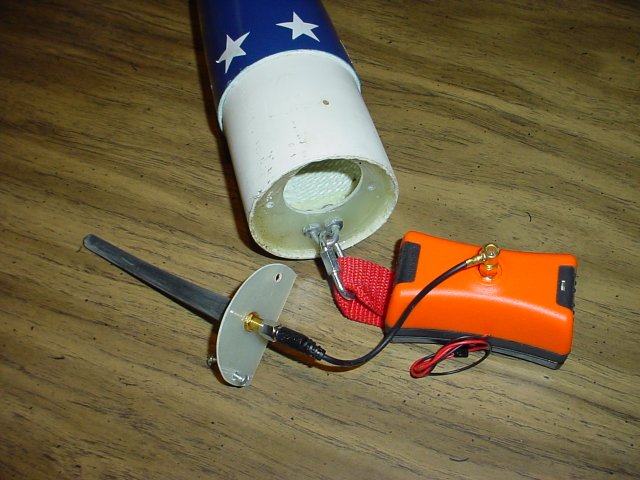
A 5 inch diameter mounting Scheme (flown twice)
Does not require antenna modifications
Drill template: http://telerover.com/rockets/GPS_Article/PR_5inch_BulkheadCouplerID_DC20_centered.pdf 
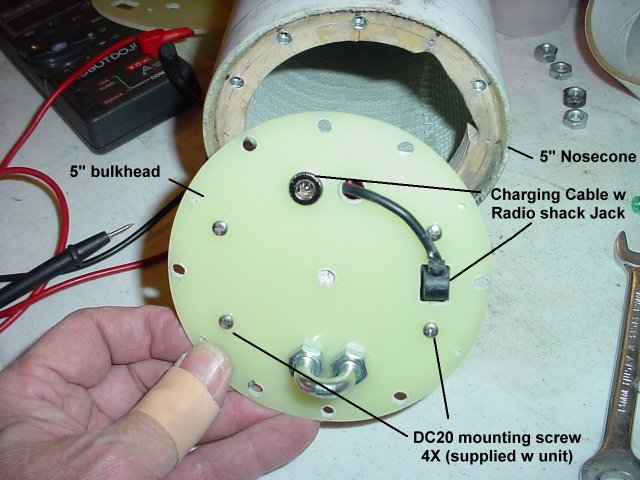
What's inside: Warning, at this point your warranty is void!
...but necessary if you want to add external power switching.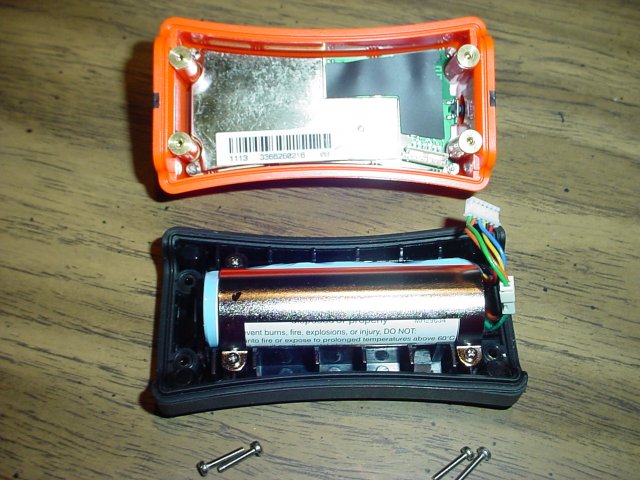
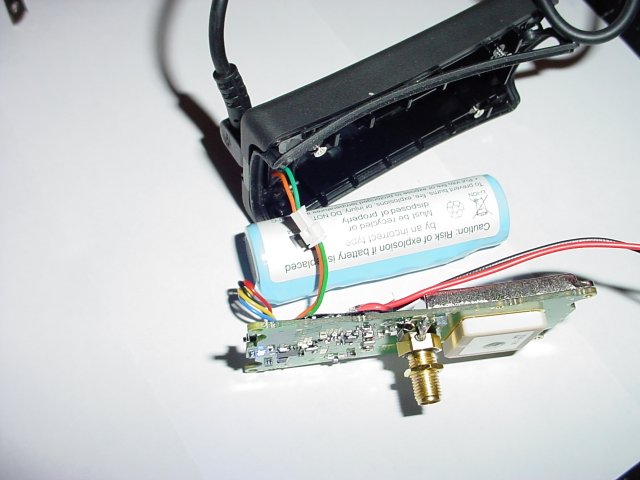
I have flown and are building other configurations as well. (Involved soldering and rewiring)
I believe I can make it fit in a 38mm airframe, but it will be permantley disfigured. 😯 Let me
know if you need help.
Warren and Eric, I think it would be a good idea to write some html to have an online pre- registration of ID numbers before folks show up to a site with conflicting ID (like the factory default setting). We use a similar system for car number in autcrossing. Here's a screen dump of what I am suggesting. Its a PHP file.
Source code: http://telerover.com/rockets/GPS/Request_DC20_ID_Number.php 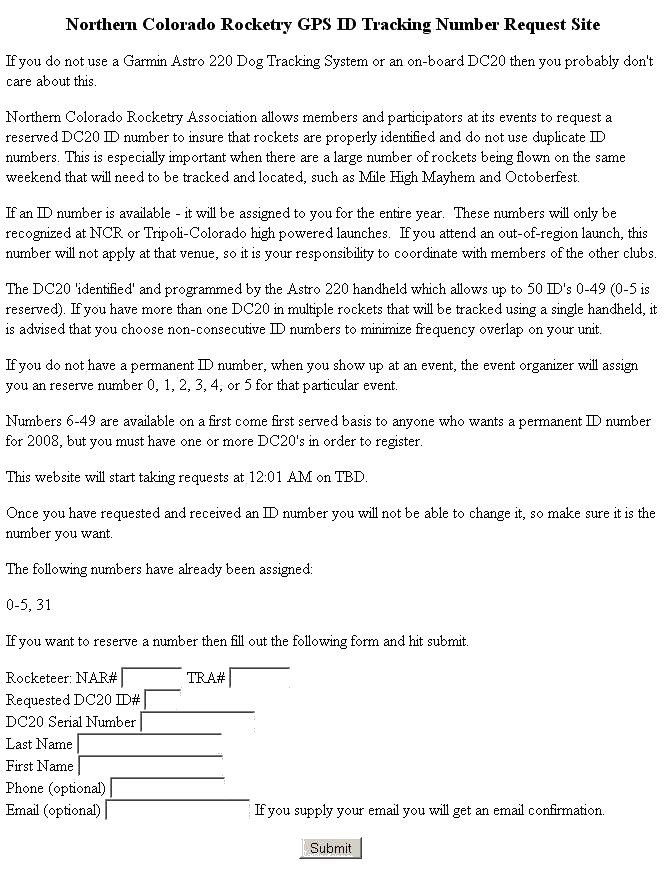
This is as far as I can go with it.
Thank you Mike. Very much appreciated. I've got to coordinate with Jeremiah as the development website is now running on a virtual machine on his laptop and he's got a large code dump we're almost ready to roll out. We can likely add this to that, but I don't want to stick it in the current live site unless I coordinate with him first. I'll post here as soon as I have some communication with him.
Warren
How about a TEST IT WITH ALL YOU ELECTRONICS!!! May have to be separated from main electronics and they to may also need to be shielded. Just a suggestion and reminder.
I would expect separation to be an absolute requirement after Mike's experience with his other transmitter rig although that was operating at significantly higher power than I expect the collars to transmit with.
Warren
The DC20 transmits at 2W power. The low end Rinos are .5W and the higher end Rinos can do 5W on GMRS.
BTW, 1/4 wavelength sensitivities are around the 6" range for FRS/GMRS, so ebay wiring is right in the ballpark for good (or bad 😕 ) reception and interference.
Ken


